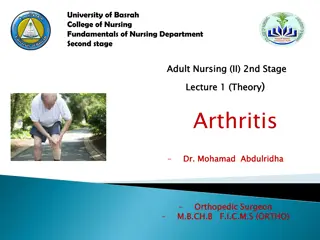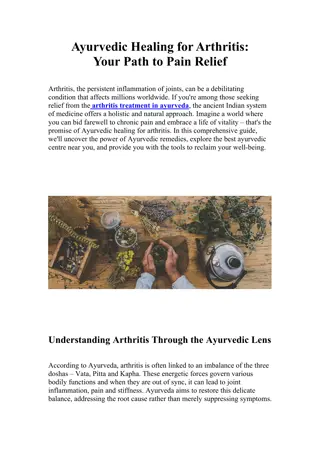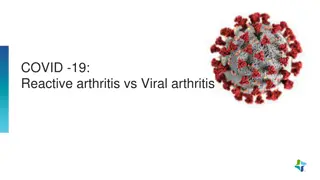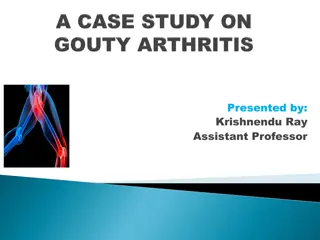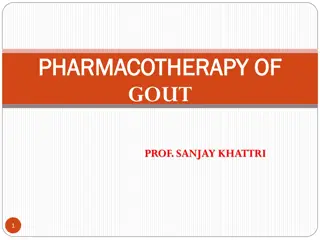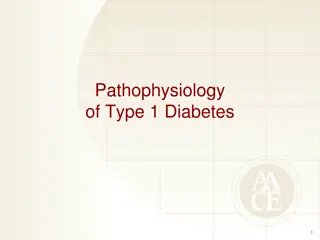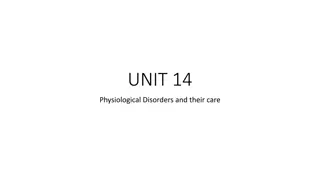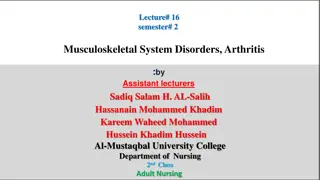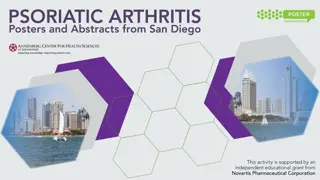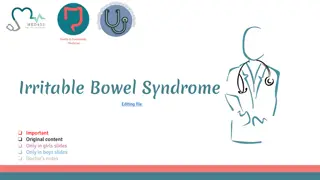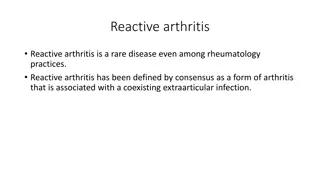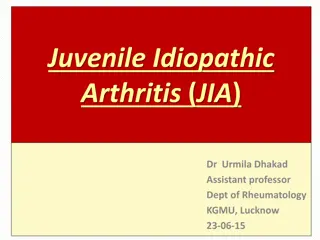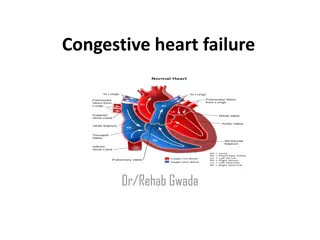Understanding Arthritis: Diagnosis and Pathophysiology
Joint pain can result from various factors such as inflammation, cartilage degeneration, crystal deposition, infection, or trauma. Different pathophysiologic processes necessitate clinical evaluation and identification through history, physical examination, and understanding of joint disease types. This includes considerations of synovitis, enthesitis, and crystal deposition in inflammatory and non-inflammatory arthritis conditions. Laboratory tests are crucial in confirming clinical impressions but should not be used indiscriminately due to their potential for misleading results.
Download Presentation

Please find below an Image/Link to download the presentation.
The content on the website is provided AS IS for your information and personal use only. It may not be sold, licensed, or shared on other websites without obtaining consent from the author. Download presentation by click this link. If you encounter any issues during the download, it is possible that the publisher has removed the file from their server.
E N D
Presentation Transcript
ARTHRITIS Approach to Diagnosis Dr Raj Kumar Yadav Assist. Prof., PMR MBBS VI Sem. 25/04/2019
Overview Overview Joint pain can have multiple causes - inflammation, cartilage degeneration, crystal deposition, infection, and trauma. - to determine the type of pathophysiologic process responsible for their presence - to localize the source of the joint symptoms. The D/D are generated - in large part from the history and physical examination. - Screening laboratory test results serve primarily to confirm clinical impressions and can be misleading if used indiscriminately.
Pathophysiology Pathophysiology Joint pain from structures within or adjacent to the joint or may be referred from more distant sites. The evaluation of joint pain, both in terms of the history and the physical examination findings, is best achieved through an understanding of the basic pathophysiologic types of joint disease. - often a difficult task - Knowledge of the anatomy Synovitis, enthesopathy, crystal deposition, infection, and structural or mechanical derangements.
Synovitis Synovitis Rheumatoid arthritis (RA) & other inflammatory arthritis Characterized pathologically: - Neovascularization - Infiltration of the synovium with lymphocytes, plasma cells, and macrophages - Synovial lining cell hyperplasia The inflamed synovium may infiltrate and erode intra-articular bone and cartilage.
Enthesitis Enthesitis transitional zone where - collagenous structures such as tendons and - ligaments are interwoven into bone. - interface between cortical bone and the periosteum - vertebral bodies and the annulus fibrosus. Seronegative spondyloarthropathies. As a result of inflammation at these interfaces, the radially oriented collagen fibers undergo metaplasia, forming fibrous bone. These metaplastic transformations result in new bone formation (periostitis), gradual ossification - syndesmophyte Secondary synovitis may develop.
Crystal deposition Crystal deposition Monosodium urate, calcium pyrophosphate dihydrate, - basic calcium phosphate (including hydroxyapatite), and calcium oxalate. Monosodium urate crystal deposition occurs - on the surface of hyaline cartilage, within the synovium, and in periarticular structures, including tendon sheaths and bursae. - localized to a bursa or tendon sheath adjacent to the joint or may be widespread, involving multiple joint structures. Calcium pyrophosphate crystal deposition - confined to hyaline cartilage, fibrocartilage, and areas of chondroid metaplasia (ie, degenerated areas of tendons, ligaments, and the joint capsule) within the joint. - Shedding of these crystals into the joint space may trigger an acute inflammatory arthritis, known as pseudogout.
Infectious arthritis Infectious arthritis The synovium may become the seat of acute or chronic infections bacterial, fungal, or viral organisms. almost always arise from blood-borne organisms and may be part of a systemic infection. intense infiltration by neutrophils with resultant necrosis of the synovium and subsequent formation of granulation and scar tissue. A dense mass of fibrin, infiltrated by neutrophils, forms over the surface of the synovium. Bacterial products released within the joint are capable of producing rapid cartilage destruction.
Structural or mechanical Structural or mechanical joint derangement joint derangement Local factors: - Previous joint trauma (eg, meniscal tears) - Developmental joint alterations (eg, congenital hip dysplasia and slipped capital femoral epiphysis) - Alterations of the subchondral bone (eg, osteopetrosis, avascular necrosis, and Paget disease) - Alterations of supporting structures (eg, hypermobility) - Cartilage derangements (eg, ochronosis and crystal deposition) Host factors: Genetic traits, Obesity Degeneration of the articular cartilage is the principal pathologic feature of osteoarthritis associated with subchondral bone sclerosis and marginal osteophyte formation may have an associated synovitis, with the formation of bland synovial effusions
Clinical Presentation Clinical Presentation - - Patient history Patient history A key initial step - joint or - an adjacent bursa, tendon, ligament, bone, or muscle or - referred from a visceral organ or nerve root. more difficult - pain is in proximal, larger joints - hip pain can arise from degenerative disc disease or stenosis of the lumbar spine, aortoiliac occlusive disease, hip arthritis, or trochanteric bursitis. the following 3 broad categories of joint disease must be differentiated: - Inflammatory arthritis - Noninflammatory arthritis - Arthralgia
Arthralgia is characterized - joint tenderness, but abnormalities of the joint cannot be identified. - fibromyalgia) or - early rheumatic syndrome whose clinical signs are not yet apparent 3 types of joint disorders may occur together in the same joint. Finally, reports of joint pain and tenderness in any type of joint disease are - influenced by the patient s emotional state and pain threshold.
Symptoms Pain Inflammatory - pain is present both at rest and with motion. It is worse at the beginning of usage than at the end. - Noninflammatory - the pain occurs mainly or only during motion and improves quickly with rest. advanced degenerative disease may also have pain at rest and at night. - Pain that arises from small peripheral joints tends to be more accurately localized than pain arising from larger proximal joints. Stiffness - With inflammatory arthritis, the stiffness is present upon waking and typically lasts 30-60 minutes or longer. - With noninflammatory arthritis, stiffness is experienced briefly (eg, for about 15 minutes) upon waking in the morning or after periods of inactivity.
Swelling - inflammatory - synovial hypertrophy, synovial effusion, or inflammation of periarticular structures. The degree of swelling often varies over time. - noninflammatory arthritis - formation of osteophytes leads to bony swelling. Patients may report gnarled fingers or knobby knees. - Mild degrees of soft tissue swelling do occur - synovial cysts, thickening, or effusions. Limitation of motion - structural damage, inflammation, or - contracture of surrounding soft tissues. - Patients may report restrictions on their activities of daily living
Weakness - Muscle strength is often diminished around an arthritic joint as a result of disuse atrophy. - Weakness with pain suggests a musculoskeletal cause (eg, arthritis or tendinitis) rather than a pure myopathic or neurogenic cause. Fatigue - Fatigue is usually synonymous with exhaustion and depletion of energy in patients with arthritis. - With inflammatory polyarthritis, the fatigue is usually noted in the afternoon or early evening. - With psychogenic disorders, the fatigue is often noted upon arising in the morning and is related to anxiety, muscle tension, and poor sleep.
Historical features important to the differential diagnosis Onset of symptoms 1. Abrupt - develop over minutes to hours - trauma, crystalline synovitis, or infection. 2. Insidious - over weeks to months. - typical of most forms of arthritis, including RA and osteoarthritis. Duration of symptoms - Acute - for less than 6 weeks - Chronic - lasted for 6 weeks or longer.
The temporal patterns of joint involvement (1) Migratory- acute rheumatic fever or disseminated gonococcal infection (2) Additive or simultaneous (3) Intermittent - intervening periods free of joint symptoms (as in gout, pseudogout, or Lyme arthritis). Number of involved joints (1) Monoarthritis. (2) Oligoarthritis - 2-4 joints. (3) Polyarthritis - 5 or more joints.
Symmetry of joint involvement - Symmetric arthritis - each side of the body - RA and SLE. - Asymmetric arthritis psoriatic, reactive arthritis, and Lyme arthritis. Distribution of affected joints - the distal interphalangeal joints of the fingers are usually involved in psoriatic arthritis, gout, or osteoarthritis but are usually spared in RA. - lumbar spine - ankylosing spondylitis but are spared in RA. Distinctive types of musculoskeletal involvement - Spondyloarthropathy - entheses, leading to heel pain (inflammation at the insertions of the Achilles tendon or plantar fascia), dactylitis (sausage digits), tendinitis, and back pain (sacroiliitis and vertebral disc insertions). - Gout commonly involves tendon sheaths and bursae, resulting in superficial
Extra-articular manifestations Constitutional symptoms - fatigue, malaise, and weight loss - underlying systemic disorder Skin lesions - SLE, dermatomyositis, scleroderma, psoriasis, Henoch- Sch nlein purpura, and erythema nodosum. Ocular symptoms - Episcleritis and scleritis - RA or granulomatosis - Wegener granulomatosis - Anterior uveitis- ankylosing spondylitis, and - Iridocyclitis - juvenile idiopathic arthritis. - Conjunctivitis - reactive arthritis.
Physical examination Physical examination Musculoskeletal examination include the following: - Inspection - Palpation - Movement - Measurement - Local motor & sensory examination - Special tests
Signs of inflammatory joint disease Swelling - Synovial hypertrophy - inflammatory - The synovial membrane is normally too thin to palpate. - In a person with chronic inflammatory arthritis, the synovial membrane has a doughy or boggy consistency, a feature best appreciated at the joint line or margin. - Joint effusions - develop in response to synovial inflammation, trauma, anasarca, hemarthrosis. detected by performing fluid ballottement or cross-fluctuation through the synovial cavity. Pain with motion - throughout the whole range of motion - acutely inflamed joint. - Not throughout the entire range of motion - an extra-articular source, such as tendinitis.
Erythema and warmth - acute inflammatory forms of arthritis, such as gout, septic arthritis, or acute rheumatic fever. - Differences in warmth can also be detected by comparing the same joint on each side of the body. Limited range of motion - inflammatory joint disease - tense effusion, a markedly thickened synovium, adhesions, capsular fibrosis, or pain. Joint tenderness - not specific Joint deformity
Signs of degenerative or mechanical joint disease include the following: Bony overgrowth of the joints- osteophytes - DIP - Heberden nodes - PIP - Bouchard nodes. Limited range of motion - intra-articular loose bodies, osteophyte formation, or subluxation Crepitus during active or passive range of motion - A palpable or audible grating sensation produced during motion Joint deformity
Monoarthritis - Acute Inflammatory Septic Arthritis Gout and Pseudogout Systemic rheumatic disease manifesting as monoarticular involvement Non-Inflammatory - Trauma Hemarthrosis Osteonecrosis
Monoarthritis - Chronic Inflammatory Chronic infectious arthritis Lyme Disease Crystalline synovitis - Gout and Pseudogout) Pauciarticular juvenile idiopathic arthritis Systemic rheumatic disease presenting with monoarticular involvement Non-Inflammatory - Osteoarthritis Ischemic necrosis - Avascular Necrosis) Hemarthrosis Paget disease involving the joint Stress Fracture Osteomyelitis Osteosarcoma Metastatic tumor
Polyarthritis - acute Rheumatic fever Gonococcal Arthritis Polyarticular gout Polyarticular pseudogout Viral arthritis (eg, hepatitis B infection, parvovirus B-19 infection) Bacterial endocarditis Rheumatoid Arthritis Still disease (systemic-onset juvenile idiopathic arthritis) Systemic Lupus Erythematosus Reactive Arthritis Acute sarcoid arthritis Mediterranean Fever, Familial Enteropathic Arthropathies
Polyarthritis - Chronic Inflammatory Rheumatoid Arthritis Systemic Lupus Erythematosus Viral arthritis Psoriatic Arthritis Reactive Arthritis Enteropathic Arthropathies Beh et Disease Ankylosing Spondylitis and Undifferentiated Spondyloarthropathy Non-Inflammatory - Osteoarthritis Traumatic osteoarthritis Hemochromatosis Amyloidosis Acromegaly
Laboratory Studies Laboratory Studies Erythrocyte sedimentation rate (ESR) - an elevated ESR supports the presence of an inflammatory arthritis. C-reactive protein (CRP) - In contrast to the ESR, the CRP level (1) can be measured on frozen serum, (2) is not influenced by the presence of anemia or hyperglobulinemia, (3) rises more rapidly in response to an inflammatory stimulus but (4) may require more time for the laboratory result to be available (ie, more than 24 hours, as opposed to 1 hour for the ESR).
RF & AntiCCP - - An RF test may be positive in as many as 20% of healthy elderly persons and in persons with other rheumatic diseases (eg, SLE, Sj gren syndrome, and vasculitis), chronic infections (eg, subacute bacterial endocarditis and hepatitis C), chronic liver disease, or chronic lung disease. - CCP antibody testing has higher specificity than the RF test but lower sensitivity. ANAs - SLE or another connective-tissue disorder. - More than 95% of patients with SLE have ANAs; thus, a negative ANA result is a strong indicator that SLE is not present. - However, a positive ANA result lacks specificity and may occur in persons with other connective-tissue diseases or certain medical illnesses, as well as in 5-10% of otherwise healthy individuals. - Test for Smith (Sm) and double-stranded DNA antibodies, which are more specific for SLE but are present in only 30% and 60% of SLE patients, respectively
Serum uric acid level Urinalysis Septic arthritis Gram stain and culture of synovial fluid Blood cultures Antistreptolysin O titer HLA-B27
Others Additional tests that may be considered antineutrophil cytoplasmic antibody (ANCA) test HIV test, a rubella titer, Hepatitis B serology, Parvovirus B-19 immunoglobulin G (IgG) and immunoglobulin M (IgM) levels Creatine kinase and aldolase level to exclude myositis Thyroid testing Chemistry profile (ie, calcium, phosphorus, electrolyte, glucose, and total protein) to exclude metabolic or endocrine disorders 25-hydroxy vitamin D level (in elderly housebound individuals, to exclude osteomalacia) electrophoresis (to exclude multiple myeloma)
Plain Radiography Plain Radiography least expensive imaging modality and most useful for clarifying the nature Rheumatoid arthritis - Early - soft tissue swelling and periarticular demineralization. - Later - include uniform loss of joint space (indicative of diffuse cartilage loss) and bony erosions (initially along joint margins where intra-articular bone is not covered by cartilage). - Advanced - diffuse bony erosions, joint subluxation, and foreshortening of digits.
Psoriatic arthritis Psoriatic arthritis - Early - soft tissue swelling occasionally involving the entire digit (ie, sausage digit) and an absence of periarticular demineralization. - Later - erosions coupled with reactive new bone formation, initially at joint margins and later within the center of the joint. - uniform joint space narrowing and ankylosis of involved joints. - Advanced changes joint-space widening in IP joints caused by severe destruction of marginal and subchondral bone resorption of tufts of distal phalanges of fingers and toes arthritis mutilans (ie, severe joint destruction) and the pencil-in-cup deformity.
Gout Gout - soft tissue swelling. - Degenerative changes of the involved joint are common. - Intercritical gout does not manifest radiographic abnormalities, apart from possible degenerative changes in the joint. - The joint space may be preserved despite extensive erosions, a finding not expected in RA. - Bone erosions are contiguous with tophi and are characterized by overhanging and sclerotic margins. - Osteolytic bone lesions occur near joints. - Periarticular demineralization is absent or mild, except late in the disease course.
Pseudogout Calcium pyrophosphate dihydrate crystal - most often in the knee, symphysis pubis, wrist, elbow, and hip. - Hyaline cartilage calcification, Fibrocartilage calcification, Synovial calcification, Capsular calcification, Extra-articular calcification occurs in tendons, ligaments, and para-articular soft tissue - Radiographic findings are the same as those for osteoarthritis. - Prominent subchondral cysts - Occasional articular destruction (resembling a neuropathic joint) with subchondral bone collapse and fragmentation and formation of intraarticular loose bodies
Infectious arthritis Infectious arthritis - Early - symmetric soft tissue swelling absence of periarticular demineralization joint-space loss (although joint-space widening may be seen initially because of fluid accumulation in a small joint space). - Later - marginal bone erosions. A periosteal reaction occurs. - Finally, gas formation within the joint and adjacent soft tissues can be seen with infections related to Escherichia coli, Enterobacter liquefaciens, and Clostridium perfringens. - Advanced - destruction of subchondral bone, bony ankylosis, and subluxation or dislocation.
Osteoarthritis Osteoarthritis Early - small osteophytes at joint margins, - focal narrowing of joint spaces (more uniform joint-space loss is noted in the IP and MCP joints of the hands - subchondral bony sclerosis in the segment affected by joint-space loss, and - absence of periarticular demineralization. Later - large and more extensive osteophytes at joint margins or at ligamentous attachments (eg, tibial spikes), - more pronounced focal joint-space narrowing, subchondral bone cysts with sclerotic margins in the areas of joints affected by joint-space loss, - and the formation of bony ossicles (round or oval fragments of bone) in soft tissues adjacent to the joint or within the joint cavity. Advanced - extensive joint-space loss and joint deformity.
Other Imaging Studies Other Imaging Studies Ultrasonography - It is safe and does not involve any exposure to radiation. - Joint aspirations and injections are greatly facilitated Computed tomography - Assessing trauma of the spine and pelvis - Evaluating arthritis in axial joints (eg, sacroiliac, atlantoaxial) - Evaluating pain in complex joints in which overlying structures obscure plain radiography views (eg, ankle, wrist, and temporomandibular joint)
Magnetic resonance imaging - best modality for assessing soft tissue and spinal cord elements Radionuclide bone scanning - widely available, and its cost is comparable to that of CT scanning. - most useful for assessing osteomyelitis, stress fractures, and bony metastasis.
Synovial Fluid Analysis Synovial Fluid Analysis Normal -clear to pale yellow color, transparent clarity -white blood cell (WBC) count lower than 200/ L with -less than 25% polymorphonuclear (PMN) leukocytes -very high viscosity Noninflammatory -pale yellow color, transparent clarity -WBC count of 200- 2000/ L with -less than 25% PMN leukocytes -high viscosity -e.g. osteoarthritis, traumatic arthritis, and an early or resolving stage of an inflammatory arthritis Inflammatory -yellow-to-white color, translucent- to-opaque clarity -WBC count of 2000-50,000/ L with -more than 70% PMN leukocytes -low viscosity -e.g. rheumatoid arthritis (RA) and other chronic inflammatory arthritides Septic -white-to-cream color, opaque clarity -WBC count higher than 50,000/ L with -more than 90% PMN leukocytes -very low viscosity -bacterial arthritis, but the fluid type also may occasionally be seen in crystalline arthritis and flares of RA Hemorrhagic -hemorrhagic color and opaque clarity -fat globules should be sought in hemorrhagic fluids by centrifuging the synovial fluid (a supernatant of fat is indicative of a juxta- articular fracture)
Crystal analysis requires - compensated polarized light microscopy - performed on a wet smear preparation of synovial fluid. Urate crystals are needle-shaped with strong negative birefringence. Calcium pyrophosphate dihydrate crystals are rhomboid-shaped with weak positive birefringence. Urate crystals appear yellow and calcium pyrophosphate dihydrate crystals blue when their long axes are aligned parallel to that of the red compensator filter.
Synovial biopsy Synovial biopsy Various granulomatous arthritides (eg, tuberculous arthritis, fungal arthritis, and sarcoidosis) Amyloidosis Synovial tumors Hemochromatosis Multicentric reticulohistiocytosis
Management Management Goals of treatment -relief of pain -restoration or maintenance of joint function -and prevention of joint damage. both pharmacologic and nonpharmacologic therapeutic modalities.
Medicines & Surgeries Patient education, Energy conservation and psychosexual rehab Intra-articular injections Management What is in our box? Exercises Orthotics Modalities


